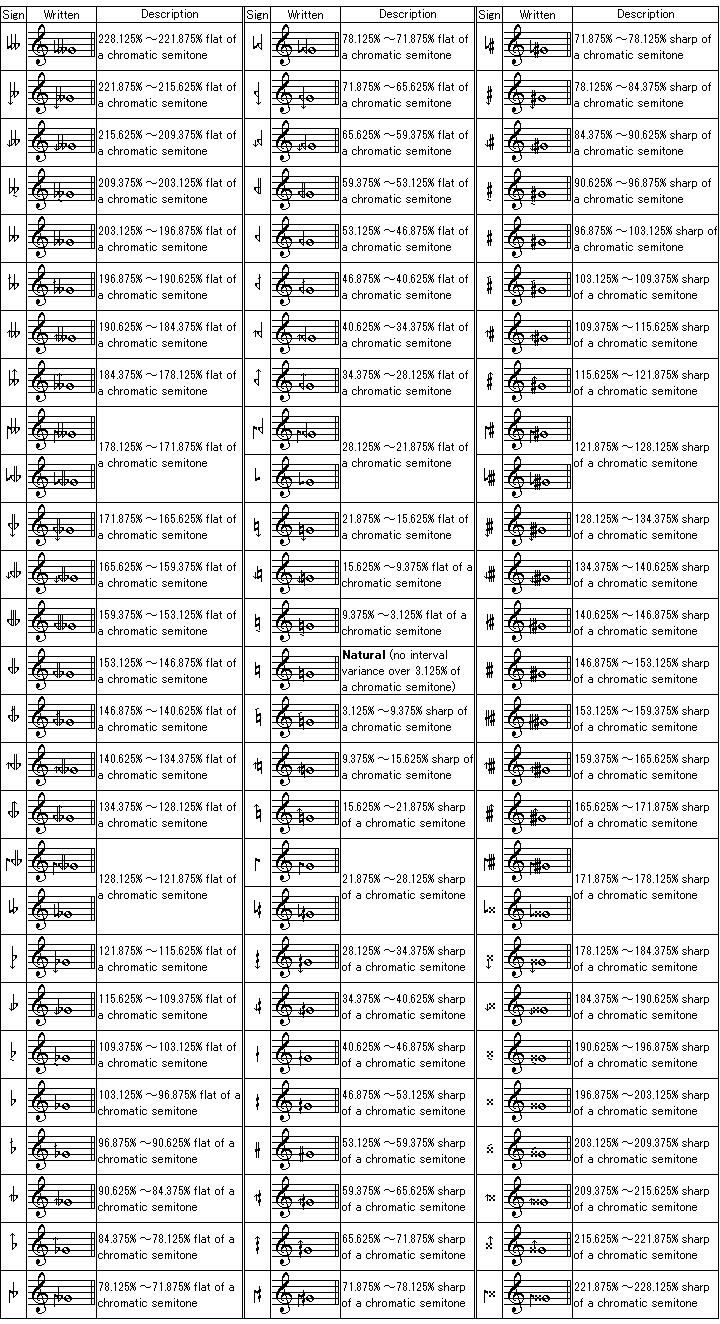User:Xenllium/Xenllium's microtonal notation
Here is a microtonal notation proposed by Xenllium on 15 June 2022.
This notation is valid for any tuning system in which chromatic semitone is represented by between 1 and 16 steps. Alternatively, EDOs with sharpness value between 1 and 16 can apply this notation. Not only for EDOs, this notation can be used for some regular tunings which have 7-tone MOS or 1/7-octave period.
Symbol set
The symbol set comprises traditional accidentals (sharps, flats, and naturals), Stein-Zimmermann quartertone accidentals (semisharps and semiflats), and additional symbols to represent microtone intervals. Some accidentals in this notation are borrowed from Helmholtz-Ellis notation and arranged to represent microtone intervals including quarter-tone, sixth-tone, eighth-tone, tenth-tone, twelfth-tone, fourteenth-tone and sixteenth-tone.
1) The traditional accidentals, as specified in this microtonal notation, modify the note by a chromatic semitone (apotome, 2187/2048).
2) The Stein-Zimmermann quartertone accidentals modify the note by half of a chromatic semitone.
3) To modify the note by a quarter of a chromatic semitone, use symbols for septimal comma in Helmholtz-Ellis notation, but also combining to quartertone accidentals.
4) To modify the note by around 1/5 or 1/6 of a chromatic semitone, use symbols for syntonic comma in Helmholtz-Ellis notation, but also combining to quartertone accidentals.
5) To modify the note by around 1/7, 1/8, 1/9 or 1/10 of a chromatic semitone, use symbols for vicesimotertial comma (left-combining up/down arrow) in Helmholtz-Ellis notation, but also combining to quartertone accidentals.
6) To modify the note by around 1/16 of a chromatic semitone, use symbols for undevicesimal comma, tridecimal third-tone or raising undecimal quartertone in Helmholtz-Ellis notation.
Usage guide
A usage guide for each sharpness value will be provided here.
Sharp-1 and sharp-2
In sharp-1 EDOs (12, 19, 26, 33, 40 and 47 EDOs) and regular tunings which have 5L 2s scale (eg. Pythagorean, meantone, schismic and superpyth), traditional notation can be used.
In sharp-2 EDOs (17, 24, 31, 38, 45 and 52 EDOs) and regular tunings which have 3L 4s scale (i.e. neutral third scales), the Stein-Zimmermann quartertone accidentals can be used.
Sharp-3 and sharp-6
In sharp-3 EDOs (22, 29, 36, 43, 50, 57 and 64 EDOs) and sharp-6 EDOs (37, 44, 51, 58, 65, 72, 79, 86, 93 and 100 EDOs), quartertone accidentals with combined arrow are used for modifying the note by 1/6 of a chromatic semitone. This accidentals can also be used for regular tunings which have 1L 6s scale (eg. porcupine and squirrel) or 2L 5s scale (eg. gravity).
Sharp-4 and sharp-8
In sharp-4 EDOs (27, 34, 41, 48, 55, 62, 69 and 76 EDOs) and regular tunings which have 6L 1s scale (eg. tetracot), accidentals for 1/8-tone are used for modifying the note by a quarter of a chromatic semitone. This accidentals are used for modifying the note by a septimal comma in Helmholtz-Ellis notation.
In sharp-8 EDOs (54, 61, 68, 75, 82, 89, 96, 103, 110 and 117 EDOs) and regular tunings which have pseudo-equalized 5L 2s scale, accidentals for 1/16-tone are used for modifying the note by a 1/8 of a chromatic semitone. This accidentals are used for modifying the note by a vicesimotertial comma in Helmholtz-Ellis notation.
